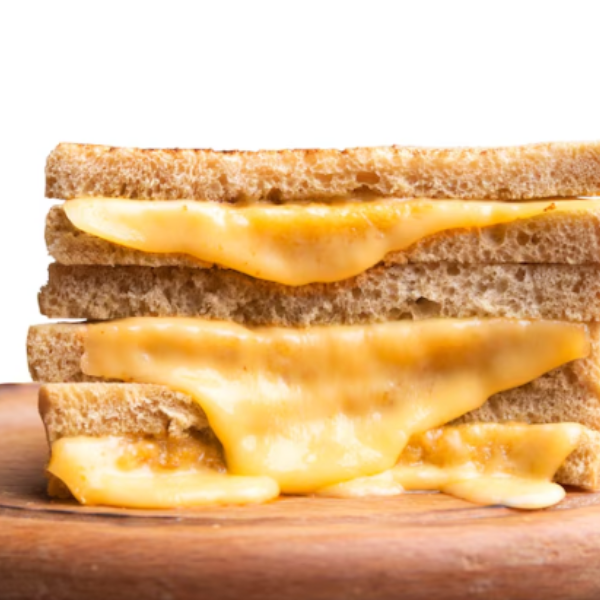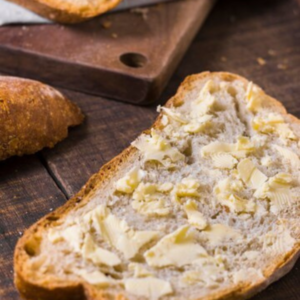Bread cheese, or Juustoleipä as it is known in its native Scandinavia, offers a delightful culinary adventure that blends tradition with versatile modern uses. This article dives into the savory world of bread cheese, exploring its origins, how it’s made, and its various culinary applications. Whether you’re a cheese aficionado or a newcomer to this dairy delight, you’ll find rich insights into making the most out of bread cheese in your kitchen.
Introduction to Bread Cheese recipe
What is Bread Cheese?
Bread cheese is a unique type of cheese that, despite its name, contains no bread! Originating from the cold climes of Scandinavia, this cheese is known for its rich, buttery flavor and slightly sweet crust that mimics the appearance of toasted bread. Its Finnish name, Juustoleipä, literally translates to « cheese bread, » reflecting its bread-like crust formed during the baking process.
Brief History and Origin
The story of bread cheese dates back several centuries in Scandinavia, where it was traditionally made using reindeer milk. Over time, as the cheese crossed borders, adaptations were made, and today, it’s commonly produced with cow’s milk. This cheese has carved out a niche for itself in the cheese market, particularly among those seeking a taste of Scandinavian culinary tradition mixed with modern flair.
Overview of Content
Throughout this article, we will delve into how bread cheese is made, its nutritional benefits, and creative ways to incorporate it into meals. From traditional Scandinavian recipes to modern adaptations, bread cheese offers a plethora of uses that go beyond the ordinary. Stay tuned as we explore the unique qualities of this fascinating cheese, providing you with all the know-how to spice up your diet with bread cheese.
Stay tuned for the next part where we will explore the making of bread cheese, detailing the process from the selection of ingredients to the final baking method that gives it its distinctive character.
Cultural Significance and Global Reach of Bread Cheese
Cultural Roots in Scandinavia
Bread cheese, or Juustoleipä, is deeply rooted in Scandinavian culture. It originated in northern Finland. This cheese is central to local cuisine and celebrated during major holidays. The cheese-making tradition has passed through generations. It symbolizes a connection to Scandinavia’s past and rugged beauty.
Expansion to New MarketsScandinavian traditions have spread globally, bringing baked cheese along. It’s particularly popular in the U.S., especially in areas with large Scandinavian communities like Wisconsin. Local cheesemakers there have adapted the traditional recipe. They use local cow’s milk, blending homage with American tastes. This adaptation has boosted bread cheese’s popularity, introducing it to a worldwide audience.
Bread Cheese in Culinary Fusion
The global culinary scene has welcomed bread cheese. Chefs worldwide use it to create innovative dishes. They blend Scandinavian culinary traditions with local flavors. Bread cheese is featured from high-end restaurants to casual dining. Its versatility and unique texture make it a favorite for chefs pushing culinary limits.
Festivals and Culinary Events
Bread cheese stars at various global cheese festivals and culinary events. These events often include tastings, cooking demos, and competitions. They showcase bread cheese’s unique qualities and versatility. These gatherings promote the cheese and educate the public about its cultural significance and culinary potential.
The Making of Bread Cheese recipe
Key Ingredients and Materials
The making of bread cheese begins with a selection of simple, yet high-quality ingredients. Primarily, fresh cow’s milk is used, though traditional versions may use reindeer milk. The transformation from milk to cheese involves a few essential materials including rennet, which helps in curdling the milk, and a special oven for baking the cheese to achieve its characteristic crust.
Production Process
The process of making bread cheese is a fine art that requires precision and care. First, the milk is warmed and mixed with rennet to start the curdling process. Once the curds form, they are carefully pressed into molds that give them their traditional flat, bread-like shape. The key to bread cheese’s unique texture and flavor is the baking process. The cheese is baked at a high temperature until the sugars on the surface caramelize, forming a golden, crusty exterior that is reminiscent of toasted bread.
Regional Variations
While the basic ingredients and methods remain consistent, regional variations of bread cheese can be found across Scandinavia and in areas where Scandinavian immigrants have settled. In some regions, spices or herbs are added to the cheese before baking, infusing it with local flavors. In Wisconsin, for example, cheesemakers have embraced this Scandinavian tradition, adapting it to local tastes and milk sources, which has helped popularize bread cheese far beyond its original borders.
Discover more about specialty cheeses and their regional variations by exploring the Art of Cheese Festival, where bread cheese and other rarities are celebrated.
Culinary Uses of Bread Cheese recipe
Traditional Recipes and Pairings
Bread cheese shines in traditional recipes where its unique texture and mild flavor can be fully appreciated. In Scandinavia, it is often enjoyed warmed, not melted, which highlights its buttery, pliable characteristics. Traditionally, it’s served with a dollop of lingonberry jam or honey for a simple yet delightful treat. For a savory twist, pairing bread cheese with charcuterie or pickled vegetables offers a satisfying contrast of flavors.
Modern Adaptations
The versatility of bread cheese allows it to adapt seamlessly into modern cuisine. It can be diced and added to salads for a protein boost or melted into a skillet to create a cheese crust for burgers or sandwiches. Innovatively, it has found a place in ketogenic diets as a bread substitute in grilled cheese sandwiches, proving that bread cheese is not only traditional but also a modern culinary marvel.
Serving Suggestions
Whether you’re looking to enhance a breakfast, a hearty lunch, or a light dinner, bread cheese provides a multitude of serving options. It’s delightful when grilled until smoky and gooey, making it an excellent base for a breadless pizza or a warm addition to your morning eggs. For those who enjoy experimenting, try sautéing slices of bread cheese and serving them with fresh herbs and a drizzle of olive oil for a Mediterranean touch.
Nutritional Information of bread cheese recipe
Caloric Content and Health Benefits
Bread cheese is not only delicious but also offers a decent nutritional profile. It is rich in calcium and protein, essential for bone health and muscle maintenance. Depending on the milk used, it can also be a good source of vitamins A and B12. While it is higher in fat, the fats are mostly saturated, which should be consumed in moderation.
Potential Dietary Restrictions
For individuals with specific dietary needs, it’s important to consider a few aspects. Bread cheese is naturally gluten-free, making it a suitable choice for those with gluten sensitivities or celiac disease. However, since it is a dairy product, it is not suitable for vegans or those with lactose intolerance. Always check with a health professional if you have dietary concerns related to consuming dairy products.
Pairing Bread Cheese recipe with Drinks
Best Drinks to Pair
When it comes to enhancing the flavor of bread cheese, pairing it with the right drink can make all the difference. A crisp apple cider, sparkling with effervescence, complements the mildly sweet, buttery notes of the cheese perfectly. For a more traditional Scandinavian experience, a steaming cup of black coffee can be delightful, especially with warm bread cheese dipped into it, creating a savory and unique breakfast option.
Coffee and Other Beverages
Beyond cider and coffee, bread cheese pairs well with a variety of other non-alcoholic beverages. Herbal teas, such as chamomile or mint, can bring out the subtle flavors of the cheese, while a cold glass of milk accentuates its creamy texture. For those looking for something a bit more adventurous, try pairing it with a homemade fruit smoothie for a balance of sweet and savory.
Consumer Guide of Bread Cheese recipe
Finding bread cheese can be an adventure in itself. It’s often available at specialty cheese shops and some larger supermarkets that carry artisanal cheeses. For those who prefer online shopping, several gourmet food websites offer bread cheese, delivering right to your doorstep. When purchasing, look for freshness indicators such as a firm texture and a golden, caramelized crust which are signs of a well-made product.
Storing and Preservation Tips
To maintain the quality of your bread cheese, proper storage is crucial. It should be kept in the refrigerator, wrapped in parchment paper or a cheese cloth to allow it to breathe. Avoid plastic wrap as it can trap moisture and affect the texture of the cheese. For longer storage, bread cheese can be frozen for a few months, but it’s best enjoyed fresh to appreciate its characteristic texture and flavor.
Environmental and Ethical Considerations in Bread Cheese recipe Production
Sustainable Production Practices
The production of bread cheese focuses on sustainability, especially in Scandinavia and Wisconsin. Many producers use organic milk from local farms. This minimizes environmental impacts. Farms often practice rotational grazing to maintain healthy soil and reduce carbon footprints. Sustainable practices enhance cheese quality and support ecosystems.
Ethical Sourcing of Ingredients
Ethical sourcing is key in making bread cheese. Producers choose suppliers who adhere to responsible farming and animal welfare. Cows are treated well, given space, and fed natural, non-GMO feed. Supporting ethical farms promotes animal welfare and boosts the local economy.
Community Impact
Bread cheese producers are vital to their communities. They create jobs and support local economies. Many are family-owned, with deep community ties. These businesses sponsor local events and contribute to community programs. This strengthens the link between local food production and community well-being.
Common Questions about Bread Cheese recipe
- What makes bread cheese different from other cheeses? Bread cheese is unique due to its bread-like crust formed by caramelizing the sugars during the baking process. This gives it a toasty exterior while maintaining a soft, chewy interior, unlike any other cheese.
- Can bread cheese be eaten by itself? Absolutely! Bread cheese is delightful on its own, especially when warmed slightly to bring out its buttery texture and mild flavors. It can also be a fantastic base for various toppings, adapting to both sweet and savory preferences.
- How should bread cheese be warmed up? Warming bread cheese enhances its texture and flavor. It can be gently heated in a skillet, microwaved for a few seconds, or even grilled to add a smoky note. Just enough heat to soften it, but not melt it, is perfect.
Expert Answers
- Is bread cheese suitable for people with dietary restrictions? Bread cheese is gluten-free and suitable for individuals avoiding gluten. However, as a dairy product, it contains lactose and is not suitable for vegans or those with lactose intolerance.
- How can I incorporate bread cheese into my meals? Bread cheese is incredibly versatile. It can be chopped and added to salads, melted into sandwiches, or even used as a replacement for mozzarella in dishes like pizzas and caprese salads, offering a unique twist on classic recipes.
This comprehensive guide to bread cheese covers everything from its origins to how you can enjoy it in your everyday meals. Whether you’re a seasoned cheese lover or curious about trying something new, bread cheese offers a delicious and versatile option to explore. Thank you for following along, and enjoy your culinary adventures with bread cheese!
Recommended Internal Links


